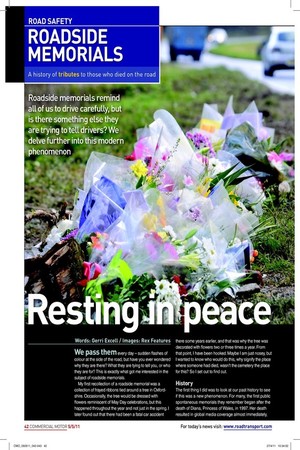Resting in peace
Page 37

Page 38

If you've noticed an error in this article please click here to report it so we can fix it.
Words: Gerri Excell / Images: Rex Features
We pass them every day – sudden flashes of colour at the side of the road, but have you ever wondered why they are there? What they are tying to tell you, or who they are for? This is exactly what got me interested in the subject of roadside memorials.
My first recollection of a roadside memorial was a collection of frayed ribbons tied around a tree in Oxfordshire. Occasionally, the tree would be dressed with flowers reminiscent of May Day celebrations, but this happened throughout the year and not just in the spring. I later found out that there had been a fatal car accident there some years earlier, and that was why the tree was decorated with flowers two or three times a year. From that point, I have been hooked. Maybe I am just nosey, but I wanted to know who would do this, why signify the place where someone had died, wasn’t the cemetery the place for this? So I set out to find out.
History
The first thing I did was to look at our past history to see if this was a new phenomenon. For many, the first public spontaneous memorials they remember began after the death of Diana, Princess of Wales, in 1997. Her death resulted in global media coverage almost immediately, and the television cameras filmed members of the public laying floral tributes at sites associated with Diana. Yet Diana wasn’t the first – one of the earliest recorded roadside memorials occurred in 1290 following the death of Queen Eleanor, wife of Edward I. Eleanor died in Nottinghamshire and her body was carried in a funeral procession to Westminster Abbey. Along the route where the funeral cortege rested overnight, 12 memorial crosses were erected, which became known as the “Eleanor Crosses” and some still stand today as permanent roadside memorials.
Once I had the history of the spontaneous memorial, I wanted to know more, not just where they were but why they occurred, and what they meant to those who built them and maintained them. This was the start of my research that continues today, and I have been privileged to speak to some wonderful people who have shared with me some very painful memories, while giving me some valuable insights into the world of roadside memorials.
Sudden bereavement
A death in a road traffic accident is sudden, traumatic and often violent; a person starts out on a journey but never reaches their destination – a life prematurely ended on the Tarmac. Families who have spoken to me about their loss repeatedly speak of the shock and pain on hearing the news that their loved one has died in this way – often alone.
Following a road traffic accident, the police, the ambulance service and the coroner all spring into action: the bereaved feel as though they have no control over the situation and that they are merely bystanders. Visiting the site of death is a very powerful experience, for it is here that you can try and visualise the last moments of your loved one’s life, what they last saw, where they took their last breath and for those who believe, where the spirit passed away. The place of death therefore becomes very important for the family: it is a place where they can immediately respond to this personal tragedy. Allowing them to mark the spot either with flowers, a cross or a personal tribute such as a football scarf is cathartic and allows them to regain some control of the situation.
In my research, I have photographed and recorded roadside memorials for more than 20 years and have seen the phenomenon grow from relative obscurity to now featuring in soap operas, music videos and even organ transplant literature. As the popularity of the roadside memorials has spread, so have urban myths about the memorials. There is a myth about police officers deliberately placing bouquets of flowers on the roadside to slow speeding drivers, for example.
The roadside memorial has etched itself into our consciousness, we know now that the sudden flash of colour on the side of the motorway acknowledges that a death occurred here. That at this spot, the lives of a family, maybe even a community, changed forever. The memorial is there to remind us of how fragile our life is and that we are all dead for a very long time. ■
● Gerri Excell is an academic at Reading University, who studied for an MA in Death & Society in 2004. Her thesis was on Roadside Memorials: Private Grief Made Public.
She has studied bereavement, mourning culture and funerals, and has presented work in Australia, the United States and Japan. She was consulted and appeared in a BBC2 documentary in 2010 “In Loving Memory” looking at roadside memorials .
















































